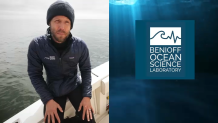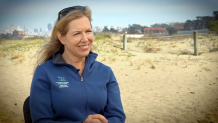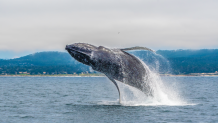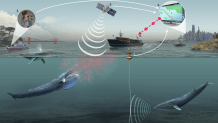About 80 endangered whales are killed off the West Coast each year by a phenomenon known as ‘ship strikes,’ which is when vessels unintentionally, and sometimes unknowingly, hit and kill whales.
The area off the San Francisco coast is home to one of the largest feeding habitats for whales in the world, but it's also the entrance and exit to one of America's busiest shipping ports. Each year, 2.4 million cargo containers come through the Port of Oakland, the tenth busiest port in America.
While ship strikes are especially devastating to endangered and threatened species, the exact magnitude of the problem remains difficult to determine.
Shipping companies are required by federal law to document each time a vessel hits a whale, but ship strikes can often go unnoticed by vessels. Scientists believe most dead whales sink to the bottom of the ocean, and so while some whales wash up dead with physical signs of a ship strike, those only represent a fraction of the total death toll, which researchers say could be 10 to 20 times higher.
The blue whale, which can grow up to 110 feet long, is the largest animal known to have ever lived on Earth, however, fast-moving ships are proving to be an even bigger adversary, one that is now pushing some species toward the brink of extinction.
Some shipping companies are simply just totally disregarding this risk for running over endangered whales
Douglas McCauley, Benioff Ocean Science Laboratory Director
“We're talking about skyscraper-sized ships that belong to billion-dollar companies,” said Douglas McCauley, who heads the Benioff Ocean Science Laboratory. “Some shipping companies are simply just totally disregarding this risk for running over endangered whales."

In hopes of reducing ship strikes, the federal government instituted a voluntary speed limit of 10 knots, during peak whale months, for large ships entering and leaving the Bay. While the annual program is nearly a decade old, the NBC Bay Area Investigative Unit has learned ships are still speeding – sometimes at more than twice the limit.
Since the start of this year’s slow down – which runs from May 1 to Dec. 15 – more than 670 large ships have traveled through the Bay, breaking the speed limit 40 percent of the time.
“We’re not reaching the goals that we wanted,” said Maria Brown, a superintendent with NOAA, the agency in charge of the voluntary slow-down program. “We're trying to figure out what are the best strategies that we should be implementing.”
The NBC Bay Area Investigative Unit has spoken with Brown several times over the years to speak about the lack of compliance within the shipping industry.
“It just seems that if you spend years asking companies to voluntarily do something and they choose not to do it, it might be time to force them,” said Senior Investigative Reporter Bigad Shaban during an interview with Brown.
“And we're asking the experts, what does that look like,” Brown replied.

NOAA could choose to make the speed limit mandatory, punishable by hefty fines, but its decision is not expected until sometime in 2023, as it gains input from the public and the shipping industry, which has long argued that slowing down could hurt its bottom line.
Large ships are required to constantly transmit their location and speed when at sea for safety reasons.
The NBC Bay Area Investigative Unit obtained and analyzed more than 25,000 of those ship traffic records and of the 10 companies traveling in and around the Bay most often, Matson Navigation, a cargo shipping company, has the worst track record, surpassing the voluntary speed limit more than 80 percent of the time so far this year.
While the recommended speed limit is 10 knots, Matson Navigation’s ships average 14 knots as it transports cars, food, household goods, and more.
“We instruct all of our vessels to abide by these voluntary programs to the greatest extent possible, given our operational requirements, and we do slow significantly through these areas,” a company spokesperson wrote in a statement.
The Investigative Unit also learned cruise lines are frequent offenders, too. While their average speed is less than one or two knots above the voluntary limit, Celebrity still cruises past that recommend speed about 64 percent of the time. Carnival and Princess cruise lines travel above the recommended limit about 50 percent of the time.
Princess said it has “clear guidelines” for when whales are spotted nearby, which “include altering course and reducing speed as required.” The company, however, said “on occasion there are circumstances beyond our control for situations such as medical emergency or adverse weather that require us to accelerate…”
Neither Carnival nor Celebrity responded to requests for comment.

I fear that whale populations could go extinct
Kathi George, Director of Field Operations & Response for the Marine Mammal Center
“I fear that whale populations eventually could go extinct,” said Kathi George, who heads the dispatch team at the Marine Mammal Center, which responds to wildlife strandings, including whales hit by ships. “You will see tissue that is all macerated together – broken bones in different parts of their bodies.”
Fran, a 49-foot humpback, lovingly known as California’s most-sighted whale, recently washed up dead in the Bay, a victim of a ship strike.
"Fran's death tells me that more needs to be done,” George said. “The voluntary slowdown that we have off of our coast is not enough to save all the whales.”
While the federal government’s voluntary speed limit has been in place since 2015, annual compliance among the shipping industry has plateaued in recent years, remaining around 60 percent.
“It would be like speeding through your neighborhood and caring nothing about either the speed limit or about the safety of kids and people in your neighborhood,” McCauley said. “This is what's happening, unfortunately, right here at sea.”

In an effort to reduce whale deaths, the Marine Mammal Center partnered with the Benioff Ocean Sciences Laboratory to create ‘Whale Safe,’ a sort of whale forecast for vessels, so shipping companies can better educate themselves on when to adjust speeds or routes in hopes of avoiding whales.
The online tool incorporates real-time whale sightings, satellite data that tracks likely food sources, and an underwater detection system that is attached to a buoy about 25 miles off the San Francisco coast. The technology, placed about 300 feet below the ocean’s surface, is constantly listening for the sultry sound of whales.
“This gives us visibility and lets us kind of peek under the top layer of the ocean and see what's out there,” George said. “We have an opportunity to take some action and not accept the status quo for the status quo and really make a difference.”

Since Whale Safe set up its sound detection system in August, it has been able to identify endangered whales in the area more than 300 times. Some scientists, however, remain skeptical on just how useful the program will be since it cannot pinpoint exact locations of whales.
Still, MSC – a global container shipping company – says it is already taking steps to incorporate the technology right onto its vessels.
“This live information will make it easier for the captains to be made aware, versus making the last-minute detours,” said Stanley Kwiaton, who manages MSC marine operations on the west coast. “You sometimes have to do the right thing and not always look to be the quickest, fastest. We have to all protect this planet.”
Certain whales off the California coast, like the blue whale, are so vulnerable that as little as four deaths a year could sink the population.
“It's the ecosystem of our ocean,” George said. “We shouldn't be out there accidentally or needlessly killing something because we want to get something faster or quicker.”
Additional Contributors
Design and development: Nelson Hsu and Amy O’Kruk/NBC
Watch Our Entire Series:
- Part 1: Hundreds of Endangered Whales Likely Killed off CA Coast Over Past Decade
- Part 2: ‘Ship Strikes' Killing Whales Despite Govt. Program to Slow Down Vessels
- Part 3: Trump Administration Facing Legal Action Over ‘Ship Strikes' Killing Endangered Whales
- Part 4: Environmentalists Wage Legal Battle to Curb Whale Deaths Off California Coast
- Part 5: Cruises, Cargo Ships Break Voluntary Speed Limit Aimed at Protecting Whales

